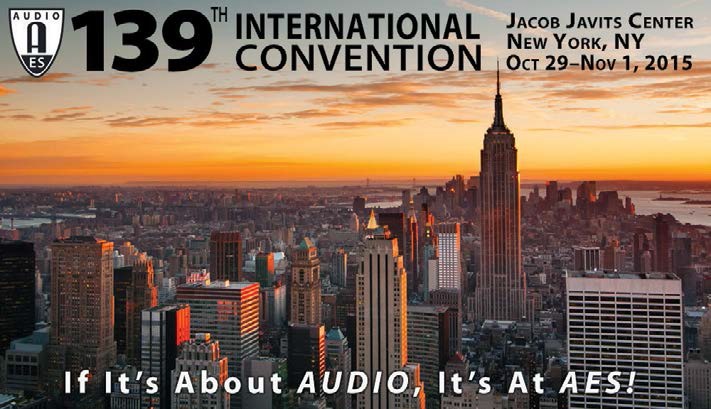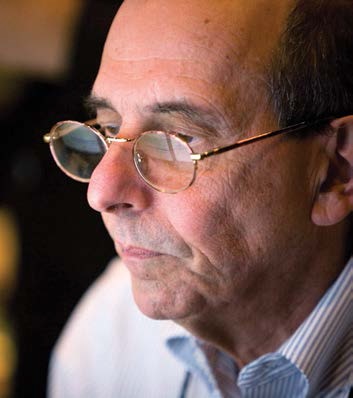AES Delves Into IP Audio, OTT
NEW YORK—Television broadcasting has gone through numerous significant changes since the first station went on-air more than 80 years ago, but nothing may prove to have such an impact on the medium as IP technology.

At the upcoming 139th AES International Convention, Oct. 29-Nov. 1 at the Jacob Javits Center in New York, a variety of panel discussions, tutorials and workshops will address the future of broadcast at this crucial point in its progress. The Broadcast and Streaming Media Track, once again chaired by David Bialik, will address a variety of IP-related issues, going to the heart of the matter and asking: “What is a broadcaster?” “Do you have to have a transmitter to be a broadcaster?” and perhaps the most provocative question, “Consider that next year, one company claims they will be the largest broadcaster in the world, and that company is Netflix.”
AUDIO OVER IP
“Streaming Audio from the Cloud,” a panel moderated by consultant John Kean on Thursday afternoon Oct. 29, will reveal some of the ways that streaming, podcasts and progressive file transfer are being used to deliver content, and the system architectures behind them. The program notes also promise discussion of loudness issues in the “Wild West” of streaming.
Several of the members of the Technical Committee on Loudness in Streaming and Network Playback, recently established by the AES, will also discuss regulations during the “Loudness for Streaming” panel later in the afternoon. The CALM Act in this country and PLOUD on the opposite side of the Atlantic have legally codified loudness controls for broadcast TV, but no such restrictions exist for the Internet yet. With the loudness war now moving to the web, AES has produced a new set of recommendations for streaming entities.
In early 2010, Reed Hundt, Federal Communications Committee chairman during the 1990s, publicly revealed that he led efforts to make the Internet the dominant communications medium during his tenure. “We decided in 1994 that the internet should be the common medium in the United States and broadcast should not be,” said Hundt. The reasoning, he said, was that “the United States had 100 percent, essentially, penetration of the telephone networks, and the world’s largest installed base of personal computers—I think it was about 50 percent in that time period.” Allowing that some of the regulations pushed through were “a little naughty,” he added, “We delayed the transition to HDTV, and fought a big battle against the whole idea but we lost.”
Twenty-one years after Hundt’s speech, Bialik has scheduled a panel that asks, “Audio and IP: Are We There Yet?” A panel of experts will discuss the many and various protocols available for audio networking and Internet delivery while also pondering the definition of broadcasting in the IP age. Attempts to invite Hundt to participate came to naught, according to the program notes.
Additional sessions covering audio over IP, with a particular focus on the AES67 standard, Andreas Hildebrand of ALC NetworX will lead a group of manufacturing reps on the possibilities of the standard in “Benefits of AES67 to the End User on Saturday afternoon, Oct. 31. The day will end with the panel, “How Will AES67 Affect the Industry,” and on Sunday, Kevin Gross of AVA Networks will chair a panel featuring Hildebrand and Greg Shay of the Telos Alliance on the equipment-oriented session, “AES67 Interoperability Testing.”
The professional video industry's #1 source for news, trends and product and tech information. Sign up below.
For those interested in how the coming 4K/UHD television standard (and beyond) will affect audio, Fred Willard from Univision will lead a panel on Oct. 31, to discuss “Audio for Broadcast—Immersive, Personalized, 4K and 8K.”

Ed Greene, mixing engineer for “The Price is Right” and “Whose Line is it Anyway?” will deliver the luncheon keynote on Friday, Oct. 30.
IMPACT OF MOBILE AND STREAMING
The theme of this year’s DTV Audio Group forum is “The Accelerating Pace of Change in Television Audio.” Tom Sahara, vice president, Operations and Technology for Turner Sports and chairman of the Sports Video Group, will get the four-hour forum started with a keynote considering the impact of mobile and fixed streaming services, which has been greater and more far-reaching than previously predicted. Among the topics on the agenda is an update on the audio standard for next-generation television and a debate on whether or not the proposed ATSC 3.0 standard currently in development will provide a template for other future audio services.
With viewers of wireless devices now reportedly outpacing traditional cable TVwatchers, “Streaming Facilities—Broadcast Scaled to Internet Feeds” will ponder the particular audio post production demands of streamed versus traditional broadcast content. Chaired by architect John Storyk, principal of WSDG, the panel will compare and contrast audio post requirements for the two delivery formats, including facility designs, acoustic requirements and other issues.
“Audio for Over the Top Television (OTT)” will dig deeper into the topic with a panel of technology providers, content producers and service operators chaired by the Skip Pizzi, director of digital strategies for NAB.
On Friday, Oct. 30, Ed Greene, mixing engineer for “The Price is Right” and “Whose Line is it Anyway?” will deliver the luncheon keynote.
For more information on the 139th AES, visit www.aes.org/events/139.
Steve Harvey began writing for Pro Sound News and Surround Professional in 2000 and is currently senior content producer for Mix and a contributor to TV Tech. He has worked in the pro audio industry—as a touring musician, in live production, installed sound, and equipment sales and marketing—since November 1980.
